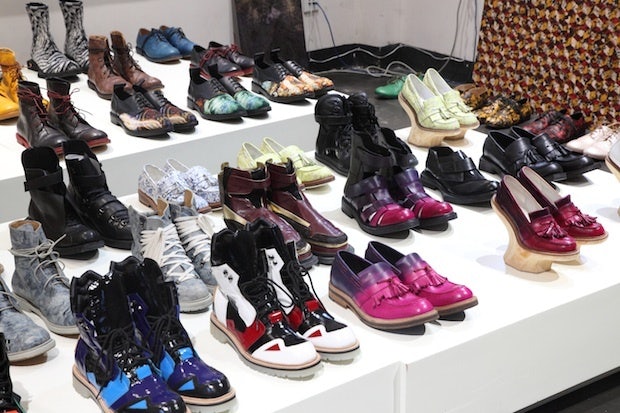
A sampling of Kim's shoe designs. (Erica Ji)
Shoe designer Kim is no stranger to international joint projects: his first collaboration with Korean menswear designer brand Juun J. was well-received by both boutiques and the international media, his collaboration with Chinese fashion icon Wyman Wong on a line of embroidered geometric-soled shoes was popular globally, his Chinese blue-and-white-porcelain-patterned clogs for UK brand Ground Zero caught a great deal of attention, his digitally-printed and embroidered shoes for Vans were a huge success, and his brand Kinkle Workshop in Tokyo’s Comme des Garcons Trading Museum is now widely acclaimed.
All the achievements above are milestones in the fantastic journey of Kim, a Shanghai-based independent shoe designer. Behind his extensive experience is not the intention to seek publicity, but a designer who is immersed in the world of shoemaking, trying to conquer every milestone.
From the establishment of his brand KIROIC to today’s Kinkle Workshop, to collaborations on designs with other brands, Kim proves himself as more than just an edgy designer. From a recent interview with Kim, we learned his thoughts on brand development and management, his exploration of shoe-making techniques, and the efforts he made to build a footwear brand that targets a niche market.
All of your past collaborators are big names in the industry. Could you share with us how those collaboration opportunities were conceived?#
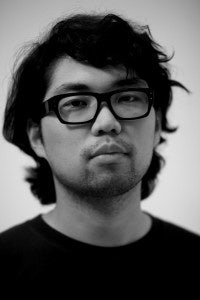
Kim.
All of my early collaborations were unplanned and it was usually not me who took the initiative. My collaboration story with Juun J. started when a PR firm in Europe suggested I work with fashion designers in Paris and design shoes for their runway shows. They introduced me to three designers, one of whom was Juun J. The fact that Juun J. is also from Asia made our communication easier; aside from that, we had similar aesthetics, he was on the rise at the time, and his garments were very practical. We had only two months to prepare for the runway show, and many communication problems arose in the process, but we still managed to pull it off. The garments from our first collaboration were both practical and trendy. I made sneaker-inspired gladiator sandals and because the idea was fresh, the collection received a lot of feedback. In the second season, I developed stronger designs and received more positive feedback.
Could you talk about your current collaboration status in Europe?#
We have suspended our collaboration. Our brand had collaborated with Juun. J. for five seasons, but Juun J. has been developing rapidly and his brand has been taken over by Samsung, and the communication between their new team and us did not go smoothly. Since we are not a large-scale business, our budget is limited, and whether there is budget for the next season highly depends on whether current season’s collection is successful or not. Such a collaborative model puts our business at a higher risk, so we stopped collaborating with Juun J.
We learned that you have recently been focusing more on Kinkle Workshop. Could you tell us more about this transition?#
KIROIC hasn’t produced a new season after the fall/winter 2012 collection. As the trend for sneakers has faded, I turned to making leather shoes. To me, this is a brand new area, since the standards of craftsmanship and materials are completely different from that of sneakers. When I designed sneakers, I usually played with the construction, or added a twist to tradition. I found that edgy designs attract a relatively young clientele, whereas quality handcrafted shoes attract an older clientele. If edgy designs and craftsmanship were put together, they would bring up the retail price, and no one would be willing to buy our shoes—unaffordable for young customers, and too flamboyant for older customers. Therefore, we created differentiation and started Kinkle Workshop. Kinkle Workshop’s concept differs from KIROIC’s; we focus less on the “design” aspect. My job is to work on Kinkle Workshop’s brand positioning, and the other 70 percent of the work is done by factory shoemakers.
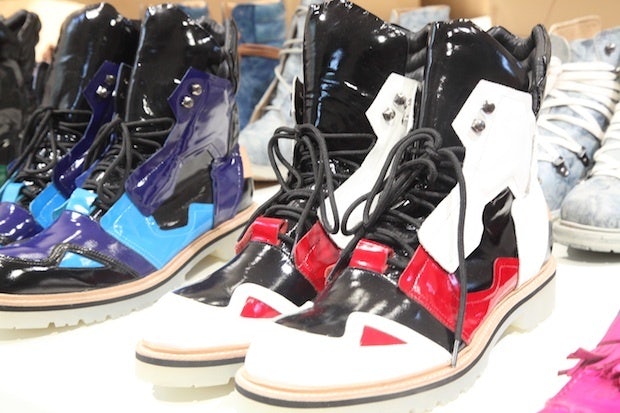
A pair of shoes designed for KKtp for Xander Zhou. (Erica Ji)
We know that factories are usually unwilling to accept small-quantity orders. How did you solve this problem?#
We used to try to collaborate with a sneaker factory in Fujian, but we could not reach the minimum order quantity; therefore, we gathered a group of shoemakers and friends, and operated a workshop-like factory. Factories in Fujian were all based on mass production, so it was hard for us to collaborate on a long-term basis with them. When I started to produce leather shoes and boots, we were lucky enough to find a factory that makes shoes for Japanese brands. Not only do they accept small quantities, they also have high standards on products; however, just like any other factory, there are issues. If they continue to invest in product development, it is hard to balance the development cost and profits. Luckily, our number of styles is limited, and most of the main differences are between colors.
Upscale materials and refined craftsmanship inevitably bring up the cost. How do you see this affecting Kinkle Workshop’s price range in the future?#
After we expand Kinkle Workshop’s product line, we will divide our products into several categories. For the best-selling Derby collection, we will increase the color options instead of investing more in product development, avoiding bringing up the cost. Since some customers do not wear bold colors, we will develop more dark-colored shoes with refined craftsmanship at a higher price. Besides, male and female customers look for different things. Female customers mainly focus on shoe styles instead of whether they are Goodyear-welted or whether they are made of imported leather. Therefore, we will create different product lines in responding to different customers’ needs.
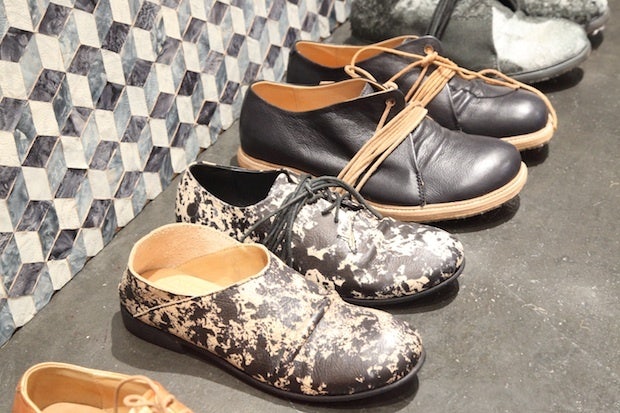
Pairs from Kim's Kinkle Workshop line. (Erica Ji)
What is your brand’s ratio between men’s and women’s shoes?#
Men’s shoes make up 60 percent, and women’s make up 40 percent, but the styles we produce are usually unisex, so the men’s shoes actually also come in women’s sizes.
Do you plan to expand your sales channels?#
We will mainly focus on selling at boutiques and multi-brand shops. Currently, Kinkle Workshop is still a brand that targets a niche market, so malls and department stores might not be appropriate sales channels for us. Instead of seeking fast growth, we are now focusing on team building.
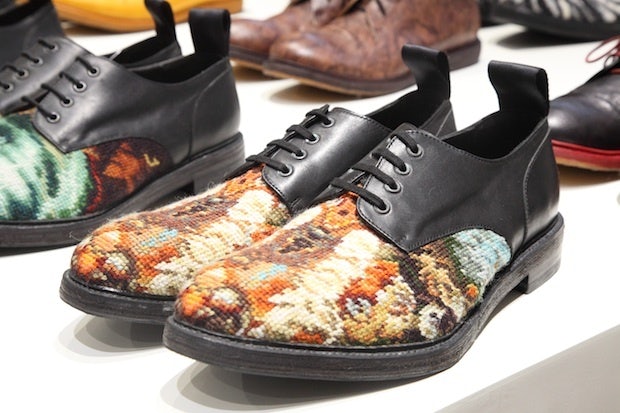
A pair of shoes from the KIROIC and Wyman collaboration. (Erica Ji)
Could you talk a little about your team?#
Currently, there are six to seven members in our team; some are specialized in design and some in marketing.
You recently established your online shopping platform. Could you talk about your future plans for it?#
I believe online platforms allow me to directly interact with customers and listen to their feedback. In fact, I define this platform as an online boutique. In the future, customers can find our collaboration products with Vans, Vans’s upscale collection, and footwear from Japanese and European brands. The goal is to build a fun, creative platform for buying shoes.
We noticed that there is a magazine section on your online platform. The content is something rarely seen in China’s mainstream media.#
My website collaborator shares his knowledge of fashion on the platform to exhibit his interest as well as to elevate the content. We plan to write more on shoe designers and shoe-care knowledge.

An inspiration board at Kiroic's workshop. (Erica Ji)
What is your future marketing plan?#
We have developed some plans and directions, but they are still not comprehensive enough. We mainly focus on reputation (word of mouth) and Weibo. We have long-term plans, too. The marketing plan has been a little different since we established the online platform. I had to stop designing shoes to think about managing the online platform and Kinkle Workshop. Right now, we’re promoting KKtP for Xander Zhou. This is a new brand targeting a younger market, and will feature a lot of collaborations with Chinese designers, such as Zhang Da, Shang Guan Ze, and Uma Wang. KKtP operates on a larger and more standardized scale than Kinkle, so it’s more appropriate for malls and department stores.
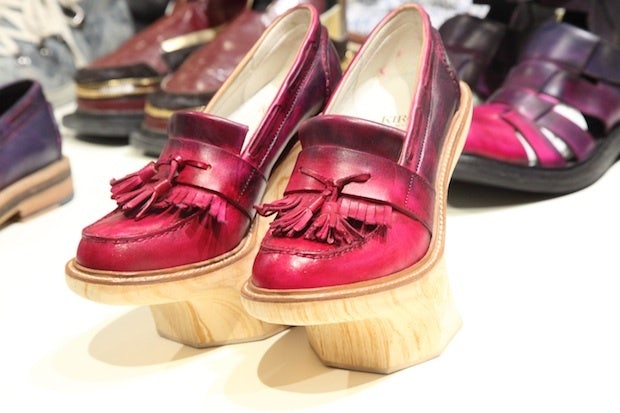
A pair of women's shoes for KIROIC. (Erica Ji)
What are your long-term expectations for the business?#
Although the operation of KIROIC is temporarily stopped, I have high expectations for it. We are searching for a better factory and are looking for premium materials around the world, trying to transform the brand into an edgy and innovative one. It is common for footwear brands to expand their product lines to apparel and accessories, but we are not planning to do that. I want to focus on footwear and develop different categories divided between upscale and mid-range lines.
This article originally appeared in Chinese. Translated by Jasmine Lu.